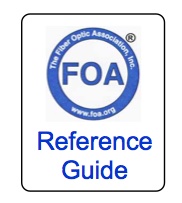FTTH
PON: Passive Optical Network
A PON system utilizes a passive optical splitter that
takes one input and splits it to "broadcast" signals
downstream to many users. This reduces the cost of the
system substantially by sharing one set of electronics and
an expensive laser with up to 32 homes. Upstream, the
passive splitter acts as a combiner to connect all users
to the same shared PON port. An inexpensive laser is used
for the home to send signals back to the FTTH system in
the central office. In the CO or head end, the OLT
(optical line terminal) has a port that connects to a
single fiber, transmitting data bidirectionally at
different wavelengths to a splitter which connects to the
ONT (optical network terminal) at multiple subscribers.
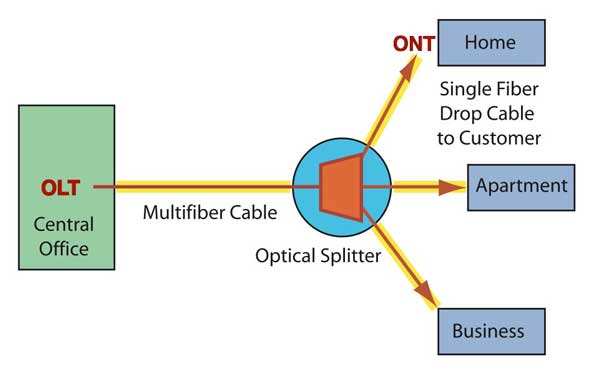
PON
network
Triple Play Systems
Most FTTH systems are so-called "triple play"
systems offering voice (telephone), video (TV) and data
(Internet access.) To provide all three services over one
fiber, signals are sent bidirectionally over a single
fiber using several different wavelengths of light.
Other
Uses For PONs
PONs
offer low cost connectivity for a large number of users
with high security and relatively low management needs.
Some PON suppliers have been promoting PONs as an
alternative to LANs (Local Area Networks), which are
especially attractive to organizations with large numbers
of users. Passive
Optical LANs are claimed to be less expensive than
traditional copper cabling for LANs but offer virtually
unlimited future expansion. See
Premises/Networks
for more information on POLs.
APON: The first PON standard, APON,
was quickly replaced by BPON because it had no provision
for broadcast video and digital TV was several years away.
BPON, or
broadband PON, was the first popular PON application for
FTTH but most systems have been updated with GPON. BPON
uses ATM as the protocol. ATM was widely used for
telephone networks and the methods of transporting all
data types (voice, Internet, video, etc.) are well known.
BPON digital signals operate at ATM rates of 155, 622 and
1244 Mb/s. Video was carried using analog techniques
at a different wavelength.
Downstream digital signals from the CO through the
splitter to the home are sent at 1490 nm. This signal
carries both voice and data to the home. Video on the
first systems used the same technology as CATV, an analog
modulated signal, broadcast separately using a 1550 nm
laser which may require a fiber amplifier to provide
enough signal strength to overcome the loss of the optical
splitter. Video could be upgraded to digital using IPTV,
negating the need for the separate wavelength for video.
Upstream digital signals for voice and data are sent back
to the CO from the home using an inexpensive 1310 nm
laser. WDM couplers separate the signals at both the home
and the CO.
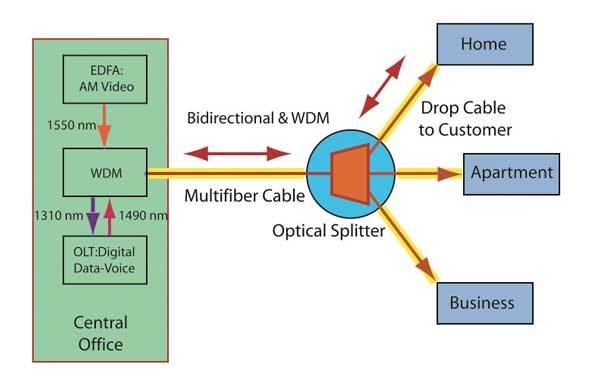
BPON
architecture with analog TV
GPON, or
gigabit-capable PON, is the most popular version of FTTH
PONs. GPON uses an IP-based protocol and either ATM or GEM
(GPON encapsulation method) encoding. Data rates of up to
2.5 Gb/s are specified and it is very flexible in what
types of traffic it carries. GPON enables “triple play”
(voice-data-video) and is the basis of most planned FTTP
applications in the near future. In the diagram above, one
merely drops the AM Video at the CO and carries digital
video over the downstream digital link.
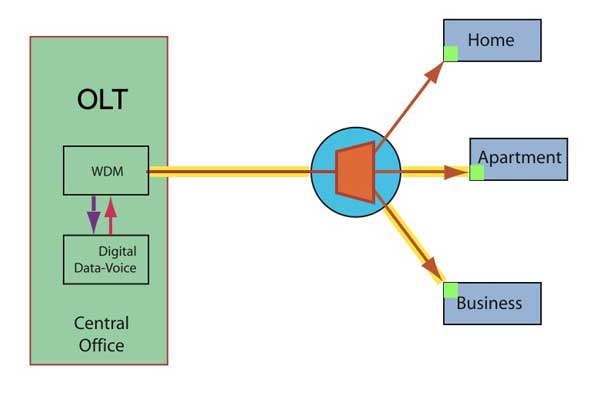
GPON adds digital IPTV to simplify the ONT

GPON ONT provides outputs for all services to subscriber
EPON or
Ethernet PON is based on the IEEE 802.3 standard for
Ethernet in the First Mile. It uses packet-based
transmission at 1 Gb/s with 10 Gb/s under discussion. EPON
is widely deployed in Asia. The system architecture is the
same as GPON but data protocols are different.
PON
System Specification Summary
|
BPON |
GPON |
EPON |
| Standard |
ITU-T
G.983 |
ITU-T
G.984 |
IEEE
802.3ah (1 Gb/s)
IEEE 802.3av (10Gb/s) |
| Downstream
Bitrate |
155,
622 Mb/s, 1.2 Gb/s |
155,
622 Mb/s, 1.2, 2.5 Gb/s |
1.25
Gb/s, 10.3 Gb/s |
| Upstream
Bitrate |
155,
622 Mb/s |
155,
622 Mb/s, 1.2, 2.5 Gb/s |
1.25
Gb/s, 1.25 or 10.3 Gb/s |
| Downstream
Wavelength |
1490,
1550 |
1490 |
1490,
1550 |
| Upstream
Wavelength |
1310 |
1310 |
1310 |
| Protocol |
ATM |
Ethernet
over ATM/IP or TDM |
Ethernet |
| Video |
RF
at 1550 or IP at 1490 |
RF
at 1550 or IP at 1490 |
IP
Video |
| Max
PON Splits |
32 |
64 |
16 |
| Transmitter
Power* |
|
OLT:
~0 to +6 dBm, ONT: ~ -4 to +2 dBm
|
|
Power
Budget*
|
~13dB
(min) to 28dB (max) w/32 split |
~13dB
(min) to 28dB (max) w/32 split
~15dB
(min) to 30dB (max)
~17dB
(min) to 32dB (max) |
|
| Coverage |
<20
km |
10,
20, 40, 60 km (versions) |
<20
km |
* There are several versions of each type that vary so
these are typical ranges.
RFOG:
CATV's FTTH
CATV
operators were the first broadband providers using a HFC
(hybrid fiber coax) system with cable modems using RF
signals. Today, some CATV operators see a need for a
system to provide fiber to the home, which has lead to the
development of RFOG (RF over Glass.) CATV standards have
looked at PON architectures and the SCTE has proposed a
standard for deploying a broadcast architecture of analog
signals similar to PONs called RFoG for RF (radio
frequency - i.e. FM) over Glass. RFOG is basically nothing
more than an all-fiber HFC/cable modem system built with
less expensive components now available thanks to the
volume pricing of components used in FTTH. It’s designed
to operate over a standard telco PON (passive optical
network) fiber architecture with short fiber lengths and
including the losses of a FTTH PON splitter.
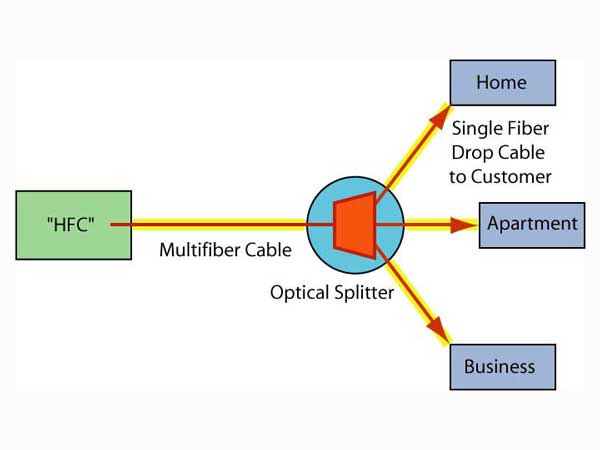
There
is one interesting aspect of this approach. Now telcos and
CATV companies can deliver the same services over the same
cable plant using totally different technologies. But that
means that office or apartment building owners, developers
or even whole towns that might be considering installing
FTTH infrastructure themselves and leasing the fiber to a
service provider can have a choice of service providers.
One cable network can support either CATV or telco systems
– or even someone else for that matter. That opens up a
big market for private fiber optic systems.
WDM
and PON
Obviously,
PON networks use WDM (wavelength-division multiplexing)
with different wavelengths upstream and downstream. But
the PON architecture can easily support more wavelengths,
allowing greater bandwidth to the user but allocating one
wavelength to a user or a group of users or greater
security by having each user have their own wavelength.
WDM PON architectures are being developed by many
companies but no standards exist for them yet.
10G
PON Upgrades - Speed, Split & Distance
As is common with all communications networks, work on
upgrading network capability and speed starts as soon as a
network is introduced and PONs are no exception. GPON has
been the most widely used PON scheme for both FTTx
netowrks and passive optical LANs (OLANs) and GPON has
been upgraded to several versions with higher transmission
speeds and higher power budgets to allow greater distance,
higher split capability, or both. The
assumption is that a fiber network has a lifetime of up to
40 years, so upgrades to GPON have assumed that they will
use the same passive optical network architecture and
fiber type (G.652 singlemode.)
Furthermore, upgrades have been designed around
coexistence with current GPON networks. By utilizing
different wavelengths, it is possible to have these newer,
faster networks sharing the same passive optical network
as the original GPON system, allowing offering higher
speeds to users while continuing to serve current users
without disruption. Some commercial users can take
advantage of higher speeds while typical consumers are
well served by GPON. One of the big advantages of the PON
upgrade standards is the ability to overlay networks. Thus
a city could operate one regular GPON network for consumer
FTTH use and have another, faster network operating on the
same cable plant independently, offering a higher level of
service and security.
Upgrade
PON System Specification Summary
|
NG-PON2 |
XG-PON |
XGS-PON |
| Standard |
ITU-T
G.989 |
ITU-T
G.987 |
ITU-T
G.9807 |
Downstream/Upstream
Bitrate
|
10/2.5,
10/10, 2.5/2.5 Gb/s |
10/2.5,
10/10 Gb/s |
10/10
Gb/s |
| Downstream
Wavelength |
~1596-1603 nm |
~1575-1580 |
Either
same as GPON if no current GPON or XG-PON for
overlay |
| Upstream
Wavelength |
~1524-1544 |
~1260-1280 |
Either
same as GPON if no current GPON or XG-PON for
overlay |
| Max
PON Splits |
64,128,
256 |
64,128,
256 |
64,
128, 256+ |
Power
Budget*
|
14-29
dB (min - max) up to
20-35 dB (min
- max) in 4 versions with up to 15 dB differential
optical path loss
|
14-29
dB (min - max) up to
20-35 dB (min
- max) in 4 versions with up to 20 dB differential
optical path loss |
13-28
dB (min - max) up to
20-35 dB (min
- max) in 6 versions with
up to 20 or 40 dB differential optical path loss
in 2 versions |
| Coverage |
20
and
40 km versions |
60
km |
60
km |
PON's Future
As with all networks, the PON industry participants work on making the
network faster and providing more reach as well as expanding the
applications. With PONs, the next step is 25G PONs and even 100G using coherent
communications. 25G PONs based on the IEEE 802.3ca EPON standard became
available in 2021 and the standard offers 50G for furure expansion, all
over the same cable plant as EPON. The coherent 100G CPON (coherent
PON) is being developed by a group at CableLabs, promising not only
higher speeds but higher split ratios - up to 512 users per OLT port.
PON applications are also expanding, covering RANs (radio access networks) for cellular wireless small cells, more LANs and even data centers.
PON
Networks - Advantages and Disadvantages
PON networks are quite different from
the typical communications network that relies on active
links and switches. Here are some differences,advantages
and disadvantages:
- No
electronics between central office/head end (OLT) and
user (ONT) means there are no electronic components
that need space for mounting, power (including
uninterruptible power), service or upgrades.
- Fewer
electronic components and the infrastructure to
support them make PONs much lower cost than P2P links
- as much as 50% in capital expense and 80% in
operating expense.
- Because
PONs are intended to carry voice, data and video,
virtually any network carrying any type of traffic can
use a PON. PONs are being used for Internet service,
connecting cellular sites, utility grid management,
erc.
- The
all passive infrastructure means that upgrades are
simpler - just change out the end electronics which
will run on the same cable plant. In fact the GPON
upgrades to 10G can run on the same cable plant
simultaneously with the lower speed GPON since it uses
different wavelengths. Thus the service provider can
have both low and high speed network service on one
cable plant, another economic advantage of PONs.
- PONs
share fibers to the splitters so they need fewer
fibers than point-to-point networks.
- Because
PONs share fibers and "broadcast" signals downstream
to subscribers, it requires encryption to ensure only
the intended recipient can receive the messages
intended for them. Thus PONs are secure, a major
advantage to organizations (governments in particular)
who are concerned over security.
- If
there is any disadvantage to a PON network over P2P it
is in the design phase where deciding on the location
of splitters for an optimal system can be more time
consuming than simple P2P links.
- Technical
Information on FTTX From The FOA
Online Guide:
- FTTH
Introduction
- FTTH
Architectures,
- FTTH
in MDUs (Multiple Dwelling Units)
- FTTH
PON Standards, Specifications and Protocols
- FTTH
Design
- FTTH
Installation
- FTTH
Customer Premises Installation
FTTH
Network Testing
FTTH
Case Studies: Do-It-Yourself FTTH
FTTH
Project Management
Migration from GPON to 10GPON
- The
Fiber Optic Association Fiber To The Home Handbook:
For Planners, Managers, Designers, Installers And
Operators Of FTTH - Fiber To The Home - Networks
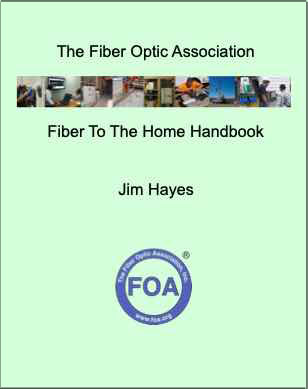
The
Fiber Optic Association Fiber To The Home
Handbook Available
in paperback or as an eBook on the Amazon
Kindle Available
direct from Amazon.com,
local booksellers and other distributors.
- Training
& Certification
Fiber
U Online FTTx Self Study Program (free)
- FOA
Certification Overview
FOA
FTTx Certification Requirements
FOA-Approved
Training Programs
Table of Contents: The
FOA Reference Guide To Fiber Optics
|
